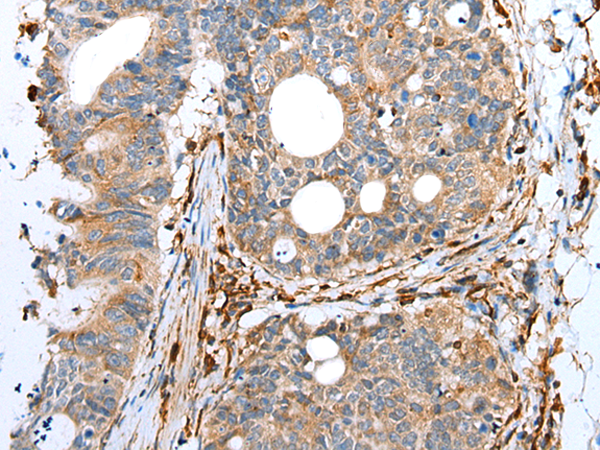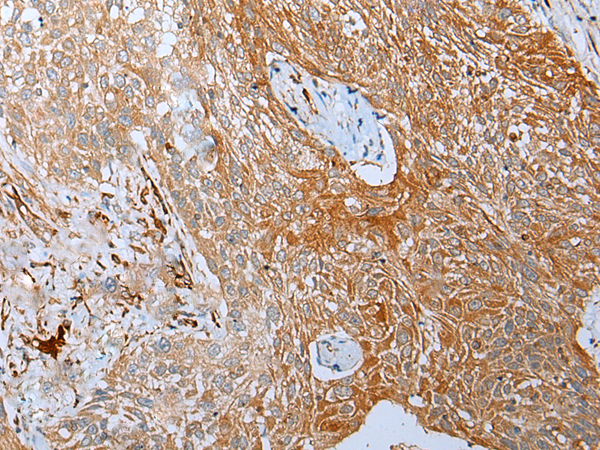

| WB | 咨询技术 | Human,Mouse,Rat |
| IF | 咨询技术 | Human,Mouse,Rat |
| IHC | 1/25-1/100 | Human,Mouse,Rat |
| ICC | 技术咨询 | Human,Mouse,Rat |
| FCM | 咨询技术 | Human,Mouse,Rat |
| Elisa | 1/5000-1/10000 | Human,Mouse,Rat |
| Aliases | BBS16; CCCAP; SLSN7; NPHP10; hCCCAP; HSPC085; NY-CO-8; CCCAP SLSN7 |
| Host/Isotype | Rabbit IgG |
| Antibody Type | Primary antibody |
| Storage | Store at 4°C short term. Aliquot and store at -20°C long term. Avoid freeze/thaw cycles. |
| Species Reactivity | Human, Mouse |
| Immunogen | Synthetic peptide of human SDCCAG8 |
| Formulation | Purified antibody in PBS with 0.05% sodium azide and 50% glycerol. |
+ +
以下是关于SDCCAG8抗体的3篇代表性文献及其摘要概括:
---
1. **文献名称**:Mutations in SDCCAG8 cause a novel syndromic ciliopathy
**作者**:Otto EA, et al.
**摘要**:该研究通过全外显子测序发现SDCCAG8基因突变与纤毛病综合征相关,利用特异性抗体证实SDCCAG8蛋白在纤毛基部的定位异常,揭示了其在纤毛组装和功能中的关键作用。
---
2. **文献名称**:SDCCAG8 interacts with RAB effector RILPL1 and is required for pericentriolar material cohesion
**作者**:Hjeij R, et al.
**摘要**:研究报道SDCCAG8与RAB效应蛋白RILPL1的相互作用,通过抗体染色和敲除实验,证明SDCCAG8对中心粒周围物质(PCM)的稳定性至关重要,突变导致纤毛发生缺陷和细胞分裂异常。
---
3. **文献名称**:SDCCAG8 is a component of the distal appendages of centrioles and regulates ciliogenesis
**作者**:Sillibourne JE, et al.
**摘要**:利用SDCCAG8抗体进行免疫荧光和超分辨率成像,发现其定位于中心粒的远端附属结构,调控纤毛形成和信号转导,为纤毛相关疾病的分子机制提供新见解。
---
这些研究均使用SDCCAG8抗体进行蛋白定位、功能验证或疾病关联分析,涵盖遗传疾病、细胞生物学和癌症领域。如需具体文献年份或期刊,可进一步补充检索。
The SDCCAG8 antibody targets the SDCCAG8 protein, encoded by the SDCCAG8 gene (Serologically Defined Colon Cancer Antigen 8), also known as CCCAP or HSPC142. This protein contains leucine zipper and coiled-coil domains, suggesting roles in protein-protein interactions and intracellular signaling. SDCCAG8 is implicated in ciliopathies, a group of disorders linked to defective cilia. Mutations in the SDCCAG8 gene are associated with Bardet-Biedl syndrome (BBS) and Senior-Løken syndrome, characterized by retinal degeneration, renal abnormalities, and developmental defects. The protein localizes to centrioles and basal bodies, critical for cilia formation and function, making it essential for studying ciliary biology and related diseases.
In cancer research, SDCCAG8 is explored as a potential biomarker due to its altered expression in colorectal and other cancers. Studies suggest its involvement in cell cycle regulation, DNA damage response, and interaction with BRCA1-BARD1 complexes, impacting genomic stability. SDCCAG8 antibodies are widely used in techniques like Western blotting, immunofluorescence, and immunohistochemistry to investigate its expression patterns, subcellular localization, and functional roles in both physiological and pathological contexts. These tools are vital for elucidating SDCCAG8's contribution to ciliopathies, tumorigenesis, and cellular homeostasis, offering insights into therapeutic targeting and diagnostic applications.
×